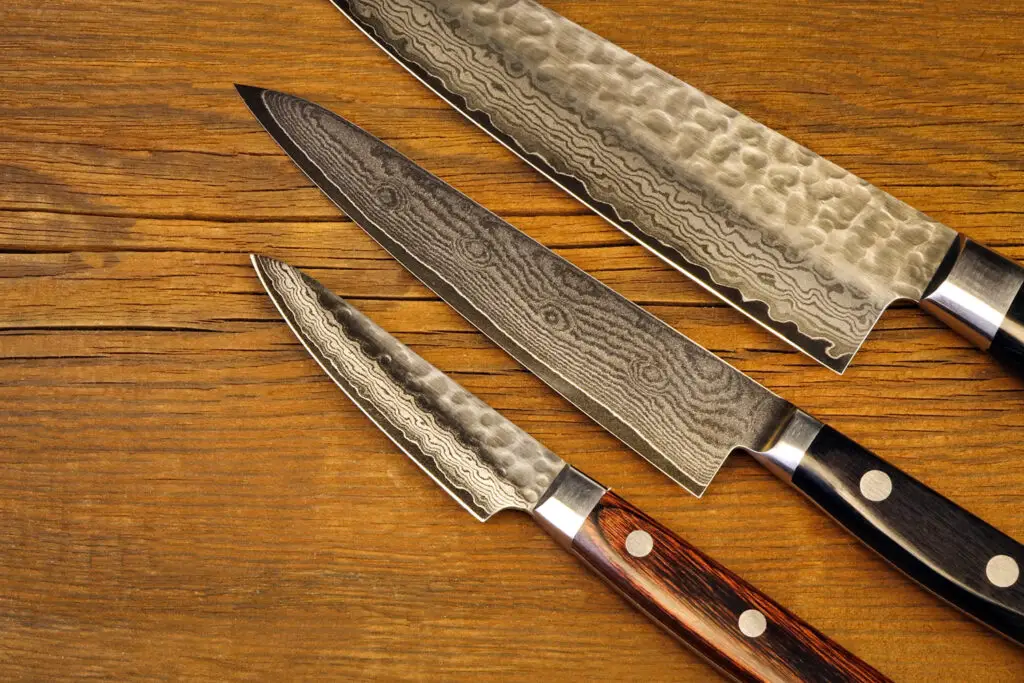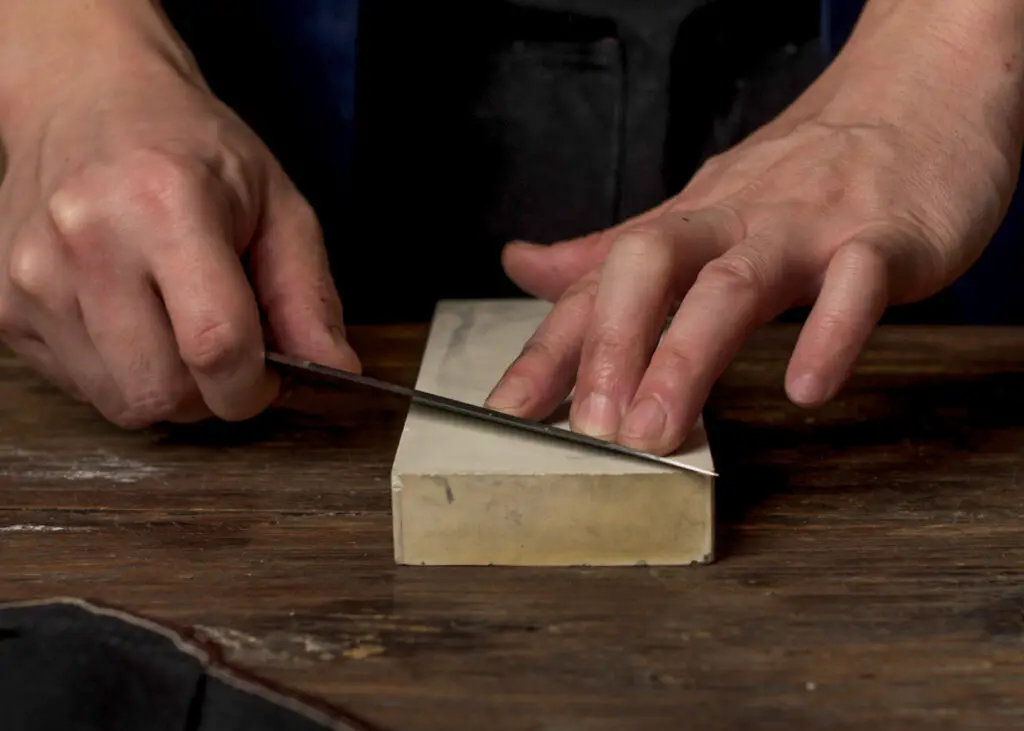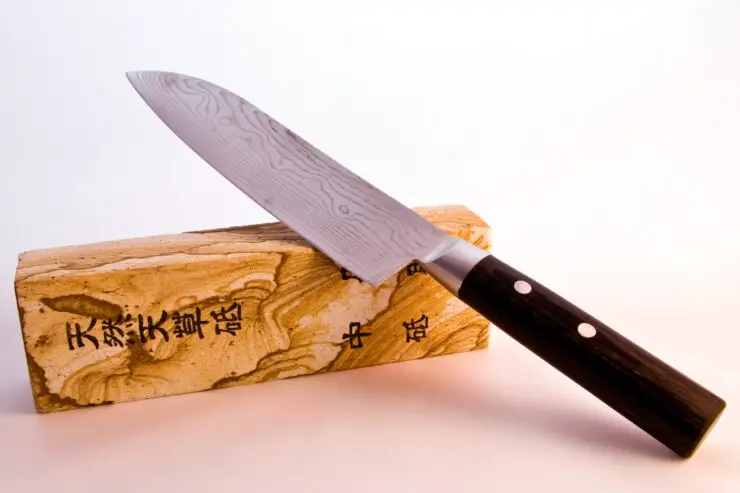As an Amazon Associate I earn from qualifying purchases. Please read the disclaimer for more info.
Have you ever marveled at the precision and beauty of Japanese knives as they slice through sushi or perfectly dice vegetables? The allure of these finely crafted tools is undeniable, with their roots tracing back to the art of samurai sword making. In this exploration of Japanese knives, we’ll uncover the fascinating history, craftsmanship, and various types that make them so sought after. Understanding their unique characteristics and learning how to properly maintain your Japanese knives will elevate your culinary skills and enhance your kitchen experience.
Key Takeaways
- Japanese knives are renowned for their craftsmanship, precision, and aesthetic appeal.
- Different types of Japanese knives have distinct features to suit various tasks.
- Careful consideration is necessary when selecting a knife that suits individual needs and preferences.
The Allure of Japanese Knives

Japanese knives are renowned for their:
- Razor-sharp edge
- Aesthetic appeal
- Extraordinary craftsmanship
- Attention to detail
These qualities make them popular among professional chefs and home cooks. Japanese knives have a long tradition, with methods of production dating back over 800 years to the techniques used to make Samurai swords. Their exceptional quality and reputation have made them one of the most coveted tools in kitchens around the world.
Sakai City, located in Osaka Prefecture, is the heart of Japanese knife production and home to numerous skilled artisans and craftsmen who have been fabricating top-notch knives for centuries. Known for their quality and craftsmanship, Sakai-produced knives are constructed using superior materials and are designed to remain sharp for an extended period.
The subsequent sections delve into the impact of samurai swords and Sakai City’s history on the evolution of Japanese knives.
Samurai Swords’ Influence
The history of samurai swords dates back centuries to ancient Japan, with the development of these swords tracing to the Heian period (794-1185), when the tachi sword was initially used. The sharpness and precision of samurai swords have greatly impacted Japanese knives, creating highly effective and efficient cutting tools.
The craftsmanship and skill necessary to create these swords were highly esteemed, and the legacy of samurai swords is still widely acknowledged today.
Sakai City: The Heart of Japanese Knife Production
With a history stretching back over 1,500 years, Sakai City has long been a prosperous trading port and a hub for the production of swords and other traditional Japanese crafts. The city is celebrated for its craftsmanship, and numerous adept artisans and craftsmen have made Sakai City the center of Japanese knife production.
Some of the most renowned brands of knives produced in Sakai City include Sakai Takayuki and Tojiro, both known for their high-quality knives and centuries of expertise.
Related: The Best Japanese Knife Set: A Guide to Choosing the Right Set
Types of Japanese Knives
Beyond their rich history and craftsmanship, Japanese knives come in various types, each designed for specific tasks in the kitchen. Among the most popular are the Gyuto, Santoku, and Nakiri knives. These knives, crafted with the same attention to detail and precision found in samurai swords, have unique features that make them invaluable tools for chefs and home cooks alike.
We will examine each knife type and its distinct functions in the kitchen.
Gyuto (Chef’s Knife)
Gyuto knives, sometimes referred to as Japanese chef’s knives, are known for their versatility and are commonly used for slicing, dicing, and chopping a variety of ingredients. These knives are typically thin and sharp, making precise and efficient cutting possible due to their exceptional edge.
Comparable to a Western chef’s knife in terms of its all-purpose nature, a Gyuto knife is generally thinner and sharper, making it more suitable for accurate and efficient cutting.
Santoku (Multipurpose Knife)
Santoku knives, also known as multipurpose knives, are perfect for cutting:
- meat
- fish
- vegetables
- fruit
These kitchen knives feature a shorter and wider blade compared to a traditional chef’s knife, allowing for more precise control and efficient cutting.
The popularity of Santoku knives among home cooks is due in part to their versatile cutting capabilities, making them an ideal tool for a variety of tasks in the kitchen.
Nakiri (Vegetable Knife)
Nakiri knives and boning knives are designed specifically for cutting vegetables and deboning meat, respectively. With a thin, straight blade for precise cuts, the flat edge of the nakiri knife enables users to push the knife straight down into the cutting board, resulting in a clean and even cut.
This makes Nakiri knives a popular choice among professional chefs and home cooks who frequently work with vegetables, as they provide efficient and precise cutting for all types of vegetables.
Related: Choosing the Best Nakiri Knife in 2024
Comparing Japanese and Western-style knives
Despite the growing appreciation for Japanese knives among chefs and home cooks, understanding the distinctions between Japanese and Western-style knives is instrumental. These differences can be found in the materials used to construct the blades and the knives’ hardness and edge angles.
A comparison of these traits will provide a deeper understanding of what distinguishes Japanese knives and how they can enrich our culinary endeavors.
Blade Materials
One of the key differences between Japanese and Western-style knives lies in the materials used for their blades. Japanese knives typically use high-carbon steel, which is harder and more brittle than the stainless steel used in Western knives. This results in a sharper edge for Japanese knives, making them more prone to chipping and requiring more frequent sharpening.
On the other hand, Western knives are made from softer stainless steel, which is more durable and requires less frequent sharpening.
Hardness and Edge Angles
Another distinguishing factor between Japanese and Western knives is their hardness rating and edge angles. Japanese knives typically have a higher hardness rating, ranging from 58 to 65 HRC on the Rockwell Hardness Scale, making them harder and stronger than Western-style knives.
Additionally, Japanese knife blades generally have a sharper edge angle, ranging from 8 to 12 degrees, making them more precise and more delicate than Western knives.
Related: The Art of the Japanese Sword
Maintaining Your Japanese Knives

Guaranteeing the lasting performance of your Japanese knives necessitates proper care and maintenance. This includes cleaning, storage, and sharpening techniques that are specific to these exquisite tools. By taking the time to learn and apply these methods, you’ll be able to fully appreciate the beauty and functionality of your Japanese knives for years to come.
Cleaning and Storage
Proper cleaning and storage of Japanese knives are essential to prevent rust and damage. Hand washing the knives with warm water and mild dish soap is recommended, avoiding abrasive sponges or scrubbers that may harm the blade.
After washing, it’s crucial to dry the knives immediately to prevent rusting. When storing Japanese knives, wooden handles should be oiled periodically to avoid drying out, ensuring the longevity of your knives.
Sharpening Techniques
Maintaining a sharp edge on your Japanese knives is vital for their performance and efficiency. Various sharpening techniques can be employed, such as using whetstones, honing with a ceramic rod, and stropping with a leather strap. Each method is effective in preserving the sharpness and edge of the knife, ensuring precise and effortless cutting during your culinary endeavors.
Mastering these sharpening techniques will unlock the full potential of your Japanese knives.
Top Japanese Knife Brands
As you explore the world of Japanese knives, you’ll undoubtedly come across some of the most popular and reputable brands, each offering their unique designs and features. Two of these renowned brands are Sakai Takayuki and Tojiro, both known for their high-quality craftsmanship and extensive range of knife styles.
A closer examination of each brand will shed light on their distinguishing features.
Sakai Takayuki
Sakai Takayuki, a renowned Japanese knife brand, has a long and distinguished history, originating in the 16th century in Sakai City. This brand is known for:
- Its traditional craftsmanship
- Superior quality knives
- A broad selection of styles ranging from classic Japanese knives to contemporary Western-style knives.
Sakai Takayuki knives are celebrated for their exceptional blade sharpness, remarkable edge retention, and exquisite blade designs.
Tojiro
Tojiro, another popular Japanese knife brand, was established in 1955 by Fujitora Industry Co., Ltd. and is known for its high-quality knives crafted with a blend of traditional craftsmanship and modern technology.
Tojiro offers a wide range of knives, including chef’s, multipurpose, and vegetable knives. With various price points, Tojiro knives are accessible to a wide range of customers, making them a popular choice for those looking to invest in high-quality Japanese knives.
Related: Finding the Perfect Japanese Pocket Knife for Every Occasion
Choosing the Right Japanese Knife for Your Needs
Choosing the ideal Japanese knife for your requirements entails an evaluation of both your cooking style and budget. By assessing the types of dishes you typically prepare and the ingredients you frequently use, you can determine the most suitable Japanese knife for your kitchen.
Moreover, striking a balance between your budget and quality considerations is pivotal to making a prudent investment in a knife that will prove beneficial in the long term, especially during sales.
Assessing Your Cooking Style
To determine the best Japanese knife for your needs, consider the ingredients you typically use and the techniques you prefer. For example, if you frequently use vegetables and favor stir-frying or sautéeing, a Santoku or Nakiri knife would be suitable.
Understanding your cooking style and habits will help you make an informed decision when selecting the right Japanese knife for your kitchen.
Budget and Quality Considerations
When selecting a Japanese knife, it is vital to strike a balance between your budget and quality considerations. While budget knives may not offer the same level of performance and durability as quality knives, they can still be suitable for everyday kitchen tasks.
Investing in a high-quality knife may provide long-term benefits, such as better edge retention and durability. Ultimately, the choice between budget and quality Japanese knives depends on your individual needs and preferences.
Summary
In conclusion, the world of Japanese knives is a fascinating blend of history, craftsmanship, and artistry. From their roots in samurai sword making to the various types of knives designed for specific tasks, Japanese knives offer a unique and unparalleled cutting experience. By understanding the differences between Japanese and Western-style knives, maintaining them properly, and choosing the right knife for your needs and budget, you can elevate your culinary skills and fully enjoy the beauty and functionality of these exquisite tools.
If you found this article useful, you might enjoy one these:
- Exploring the Versatility of a Kiritsuke Knife
- Are Dalstrong Knives Worth It? A Comprehensive Review
- 9 Best Sushi Cookbooks to Master the Art of Sushi
- 13 Best Japanese Cookbooks to Master Japanese Cuisine
- Best Japanese Chopsticks for Everyday Use
Frequently Asked Questions
What is the most popular knife type in Japan?
The most popular knife type in Japan is the Gyutou, an all-purpose kitchen knife made with thinner and harder steel than typical European knives for a better edge. It can also be referred to as the Santoku, meaning ‘knife of three virtues’ and used for vegetables, fish, and meat.
Why Japanese knives are the best?
Japanese knives are lighter, more balanced, and feature high-quality steel that stays sharp for longer – making them an ideal choice for precision work in professional kitchens. These knives are designed to be used for a variety of tasks, from slicing and dicing to chopping and mincing. They are also easy to sharpen and maintain, making them a great choice for home cooks as well.
Are knives made in Japan good?
Japanese knives are renowned for their superior sharpness, beauty, and precision, making them a popular choice among professional chefs around the world. Their unique design and craftsmanship make them stand out from other kitchen knives and are often seen as a symbol of status and prestige. The blades are made from high-quality steel, which is known for its strength and durability. This means they stay sharp for much longer than ordinary knives, making them perfect for precision work in professional kitchens. They are also typically lighter and easier to handle than Western-style blades, making them a great choice for home cooks as well.
What is the main difference between Japanese and Western-style knives?
Japanese knives are made from high-carbon steel, which makes them harder and more brittle than Western-style stainless steel knives. They also have a higher hardness rating and sharper edge angles for superior cutting power.
How often should I sharpen my Japanese knife?
Sharpening your Japanese knife depends on its type and usage, but ensuring it maintains a sharp edge for optimal performance is important.





